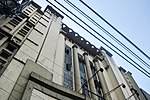Quiapo Church

The Minor Basilica of the Black Nazarene (Filipino: Basílika Menor ng Itím na Nazareno; Spanish: Basílica Menor del Nazareno Negro), known canonically as the Saint John the Baptist Parish (Filipino: Parokya ng San Juan Bautista; Spanish: Parroquia de San Juan el Bautista) and also known as Quiapo Church (Spanish: Iglesia Parroquial de Quiapo; Filipino: Simbahan ng Quiapo), is a prominent basilica in the district of Quiapo in the city of Manila, Philippines. The basilica is famous home for the Black Nazarene, a dark statue of Jesus Christ said to be miraculous. The basilica is under the jurisdiction of the Archdiocese of Manila and its current rector is Rev. Fr. Rufino C. Sescon, Jr.
Excerpt from the Wikipedia article Quiapo Church (License: CC BY-SA 3.0, Authors, Images).Quiapo Church
Plaza Miranda, Manila Quiapo (Third District)
Geographical coordinates (GPS) Address Phone number Website External links Nearby Places Show on map
Geographical coordinates (GPS)
| Latitude | Longitude |
|---|---|
| N 14.598782 ° | E 120.983783 ° |
Address
Quiapo Church (St. John the Baptist Parish Church)
Plaza Miranda 910
1001 Manila, Quiapo (Third District)
Philippines
Open on Google Maps








